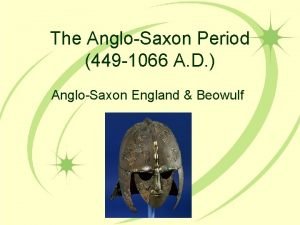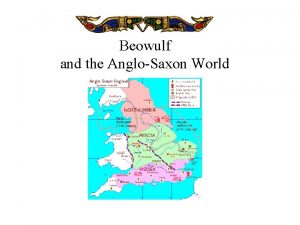The AngloSaxon World The AngloSaxon Homeland The AngloSaxon









- Slides: 9

The Anglo-Saxon World

The Anglo-Saxon Homeland

The Anglo-Saxon Invasion • 410 AD: The Romans leave Britain • 449 AD: Hengest and Horsa arrive, invited by King. Vortigern to be his allies against the Picts • Hengest and Horsa defeat the Picts and then turn on Vortigern, beginning the invasion • Thus goes the legend, but the invaders actually came as early as the 3 rd century • Major groups: Angles (Denmark), Saxons (Germany) and Jutes (Jutland Rhineland) • By the mid-5 th century, Germanic kings controlled much of Britain, particularly the eastern sections

King Alfred • Ruled from 871 -899 as King of Wessex, later King of England • Ordered the keeping of the Anglo-Saxon Chronicle • Arranged for “the books most needful for all men to know” to be translated from Latin into English • In 878, after being driven back onto the Island of Athelney in Somerset, raised an army and defeated the Vikings led by King Guthrum • As a result, England was divided into Alfred’s kingdom in the south and east and the Danelaw in the north and west.

Religion among the Anglo-Saxons • Pre-Roman Celtic origins: – supreme goddess was Nerthus, the earth mother, surrounded by pantheon of goddesses (Frea, Esotre, Rheda) • Early Anglo-Saxon religion: – Supreme god was Woden (from Viking roots) – The Wild Hunt: souls of dead warriors ride to Valhalla to join Woden’s host of champions – Frey was an important god, symbolized by a boar – Shrines in natural places rather than churches or temples • Christianity: – Absorbed earlier customs and beliefs and began the process of “Christianizing” both life and literature

Anglo-Saxon Cultural Beliefs • Comitatus (The lord-thane relationship, governed by protection and loyalty) • Wergild (the price of a man) • Wyrd (fate) • Immortality (fame) • Gift Giving (binding loyalty) • Fragility of human life (constant warfare; threatening natural forces)

Beowulf • Oldest long poem composed in English • Tale told by a scop (singer-poet) – Entertainer – Historian • Set in 6 th century Denmark and Sweden • Great emphasis on use of real people and settings • Dating by real events mentioned, Beowulf fought Grendel and his mother about 520 AD; his fight with the dragon would have taken place toward the end of that century

Rich ship burials were recorded in Sweden as early as the sixth century, and the Sutton Hoo burials were about a century later, about the time the story of Beowulf was first being told in England. A 1904 image shows the Oseberg Viking ship after its recovery in southern Norway. Scientists say DNA tests could yield new information about a queen and another woman whose remains were found in the ship.

Who wrote Beowulf? • Author unknown, probably a Christian monk working with older versions of the story • Only manuscript dated 1000 AD • Probably composed in 7 th or 8 th centuries, while memories of Germanic tales and traditions still alive • East Anglia, where ship burials were found, likely to be the place of composition
















